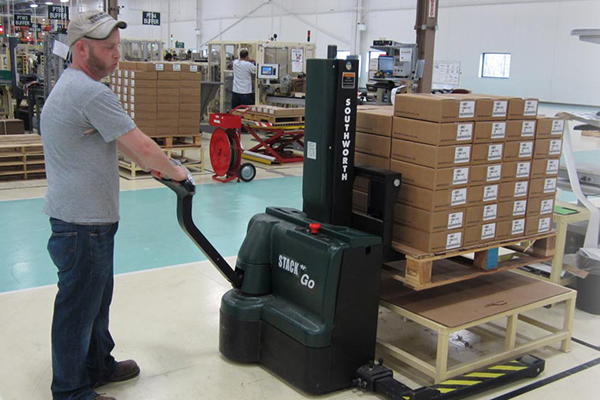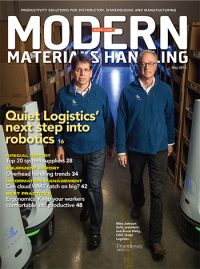Ergonomics: Take comfort in productivity
One of the best solutions to the industry’s labor shortage is to keep the workers you’ve got as comfortable and productive as possible.
When MHI formed the Ergonomic Assist Systems and Equipment (EASE) Council in 1994, it might not have predicted the council’s focus would evolve from a concern for the health and safety of workers into a central component of the health and safety of the industry. Even as automation penetrates the dirty and dull elements of materials handling, ergonomics are becoming even more important to ensure the people working with those systems can safely achieve top performance. To meet the challenges of an aging and diminishing workforce and to support exacting service levels, optimal ergonomics is critical to reduce the strain and stress on operational efficiency.
For parts of the world like Europe, Canada and Australia, ergonomics are federal law. In the United States, however, OSHA’s general duty clause might result in penalties for a company with a blatantly poor ergonomic situation. But according to Jim Galante, director of business development for Southworth Products and chairman of the EASE Council, there are very few write-ups due to poor ergonomics.
“It wasn’t that many years ago that ergonomics were a nice thing to do, but a lot has changed,” Galante says. “Even though there’s no law in the United States, there is very much an awareness, even in relatively small companies of 200 to 300 employees, of what ergonomic means. There are a number of reasons it has taken on a new and very exciting role.”
The task at hand
First, the journey to identify and remove production bottlenecks often leads to an ergonomic solution. “You almost can’t have one without the other,” Galante says, “since wasted motion, energy or some wasted resource is the root cause. It’s clear that lean methodologies and ergonomics are tied very closely.”
That said, there are some additional stressors on American industry that are hard to sidestep, such as the number of workers who are aging or, shall we say, are generously proportioned. These two factors have reached epidemic magnitude, Galante says, including a doubling of the average workforce age in the last 22 years and having a third of workers classified as obese.
Solutions to help workers remain comfortable and productive have seen wider adoption, but ergonomics requires broader thinking to bear the most fruit. For instance, processes designed with administrative controls might limit a worker to between 30 minutes and two hours performing a strenuous task before cycling them to another workstation.
Point solutions can also change processes and workflow to enhance productivity, says Mike Shannahan, owner of Cynergy Ergonomics. For example, a device for lifting and stacking 50-pound pails might not make financial sense if it is only capable of lifting one pail at a time and seems to be slower than a manual approach. But, if it can lift and place four at a time, not only will it speed production, it will do so consistently—with minimal change in throughput during the day.
Shannahan sees a trend where the future of ergonomic lift assist devices will pair the strengths of technology and robotics with the intuition and adaptability of human operators, “like bionic strength.”
“Customers are already replacing old pneumatic balancer technology with servo drive/PLC-controlled lifters for applications that can’t be automated because they need the operator’s intelligence,” Shannahan says. “Once you move into that mode, there is a tremendous amount of feedback capabilities. The lifter can tell you what’s happening, detect loads and, for example, not release a load when it detects it’s not properly seated. It’s not cheap, but the return on investment could be the next day, since the operator didn’t blow out his rotator cuff or drop and damage a valuable part.”
Because the materials being handled in each task are subject to such frequent change, Keith Soderlund, vice president of sales for Creform, says it might also be worthwhile to lean on suppliers to help maintain some consistency. To minimize worker strain—not to mention potential adjustments to storage dimensions—a distributor might enforce limitations on the size and weight of cases.
No stone left unmeasured
The size and weight of equipment itself is also worth thinking about. Mobile workstations and carts, in an effort to reduce the time spent walking, are often burdened with computers, batteries and a structural frame designed for long-term, heavy-duty use. The cart might last for many years, but the operator will be saddled with its weight and other ergonomic limitations for the duration.
“You have to find a balance,” Soderlund says. “It’s easy to design a cart and say it works fine two or three times, but what about two or three thousand times?”
No feature of a cart or mobile workstation should escape scrutiny over time, and Soderlund suggests it might make sense to overbuild initially and gradually dial it back as the needs of the application are better understood. Whatever the starting point, weight reduction goes beyond the metal frame. Casters can have a massive impact on rolling resistance, Soderlund says, and can undercut the effectiveness of an otherwise ergo-centric design.
“It’s like driving a car with deflated tires,” he says. “Caster quality varies from $10 to $300, but there are reasons why the prices are different. It’s an area where people like to scrimp, but they will live with that decision for a long time.”
Battery weight can also be an issue. Lithium-ion batteries are significantly lighter than conventional lead-acid batteries, which lends them to light carts as well as light handling during battery changes. According to John O’Kelly, president of Newcastle Systems, the 60-pound conventional batteries could be swapped, but in practice rarely are. This choice makes an impact in two- and three-shift applications where it is more efficient to use the same cart throughout the day.
For fixed workstations, manual or electronic height adjusters can improve conditions for both the 5-foot and 7-foot employees who use it. Taking that idea a step further, Michael Renken, vice president of sales for Advance Lifts, notes increased interest in solutions that bring the employee to the work. Building on rider mezzanine lifts that eliminate the need to send product on a lift and a worker up and down stairs, the concept of a platform-mounted office reduces the time and effort to walk from the lift or upper mezzanine to a floor-level workstation.
“One customer had used ladders to observe manufacturing processes at height, and had to descend and walk to the controls to make adjustments,” Renken recalls. “The in-the-air office puts the controls up there with him. These solutions often create a one-person job where it previously required two.”
Once elevated, there are still opportunities for ergonomic improvement. Renken says many who already use lifts can benefit from platform extensions that extend the work area’s width or length.
“They’ll often say, it’s only 6 inches, we’ll just bend over further, or move the entire system in and out, but it’s much more efficient for the platform to have an extension,” Renken says. “It depends on the customer, but we see more proactive decisions when they have a safety department or professional. There wasn’t as much of that oversight 15 years ago, when it was a reactive response after someone got injured.”
It doesn’t take an injury for an employee to leave an unpleasant job, and curbing turnover is also top of mind. Louis Coleman, director of sales and marketing for Autoquip, says the right solution can even open up the potential labor pool, for instance by making a lift or mobile office wheelchair-friendly. The productivity benefits are an added bonus. He offers the example of a customer who purchased their first lift to assist an employee who had suffered a back injury.
“Then they came to us and asked for 14 more,” Coleman recalls. “I asked if the other workers had become jealous, but he said it was because the injured employee had become so much more productive that he saw the value for the rest of the crew.”
The well-being of the worker and workplace
Newcastle’s O’Kelly says his company has done research into the ergonomic priorities of its customers. He says a lot of attention focused on comfort in manufacturing operations, but warehousing is often run on a bare budget. This is largely due to the quantifiable nature of manufacturing processes, where an ergonomic solution can be seen to uphold measurable rates of performance. Metrics like stock-to-dock and order-processing rates can inform the warehousing side, O’Kelly says, but because the overall cost of the warehouse function is less, it’s more difficult to get enough attention to invest in improvements.
“A lot of people have a very old-fashioned view of warehousing, and many don’t know how long it takes to unload a trailer,” he says. “They might not collect data or do much with the data they collect. They’ll say a person picked 50, but there’s no perspective. If the industry average is 100, they’re none the wiser.”
The impact of ergonomics on process improvement must be a regular part of equipment selection and specification, according to Creform’s Soderlund. There are quantitative guidelines for ergonomic impacts, but many customers are evaluating applications more subjectively, he says.
“How does the worker feel? This should be a daily conversation,” Soderlund says. “From plant production to engineers, we see variety of knowledge about ergonomics and related concerns. The person actually using the equipment should be the focus. Honest worker feedback should be encouraged and received, which generates automatic buy-in and a level of ownership that will improve conditions, retention and productivity.”
Companies mentioned in this article
- Advance Lifts
- Autoquip Corporation
- Creform Corporation
- Cynergy Ergonomics
- Newcastle Systems
- Southworth Products

Article Topics
Ergonomics News & Resources
Advance Lifts marks 50th anniversary Shift Robotics demonstrates warehouse Moonwalkers HeroWear demonstrates a back-assist exosuit SIGI announces key leadership promotions Autoquip Corporation acquires German company J.A. Becker & Söhne Monorail Manufacturers Association celebrates 90 years of monorail best practices Caster Concepts expands manufacturing facility in Albion, Mich. More ErgonomicsLatest in Materials Handling
Registration open for Pack Expo International 2024 Walmart chooses Swisslog AS/RS and software for third milk processing facility NetLogistik partners with Vuzix subsidiary Moviynt to offer mobility solutions for warehouses Materials Handling Robotics: The new world of heterogeneous robotic integration BSLBATT is looking for new distributors and resellers worldwide Lucas Watson appointed CSO for Körber’s Parcel Logistics business in North America Hyster recognizes Dealers of Distinction for 2023 More Materials HandlingAbout the Author
Subscribe to Materials Handling Magazine

Find out what the world's most innovative companies are doing to improve productivity in their plants and distribution centers.
Start your FREE subscription today.
April 2024 Modern Materials Handling

Latest Resources












